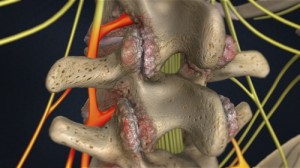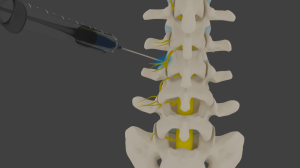Medial branch blocks are an injection of local anesthetic and steroids near the nerve endings that supply a particular spinal joint. Specifically, facet blocks are the same injection injected directly into the joint in the spine versus the area around it. This treatment is often
used as part of a two-step diagnostic treatment.
Research shows that medial branch blocks can be used as therapy or for diagnosis. After the block has been injected, one of three things may happen. The first thing that can happen is that the pain does not go away. This means that the pain is not coming from the facet joints that were blocked by the procedure.
The second thing that can happen is that the pain does in fact go away but returns. This tells the Workers Compensation pain doctor that the pain is coming from the blocked branch, but that the block was not successful. Lastly, the pain comes and goes, but increasingly gets better. This means that the block was therapeutic and the steroid had a long lasting effect.
The procedure itself has been reported by patients as being as painful as a sting or
burning sensation. The workers comp doctor uses a small needle that in inserted beneath the skin and into the deeper tissue. Patients do not need to be put under for this procedure. A numbing agent applied beforehand helps ease the pain, if any, that a patient experiences. After the procedure, patients need to move slowly and allow the block some time to take effect. Patients are advised to rest.
Research shows that branch blocks have had great success in pain relief. This pain relief lets patients resume their daily lives. This is not always achieved with oral medication or physical therapy. In a study conducted by J. Friedly, L. Chan, and R. Deyo, published in 2007, medial branch blocks have increased dramatically in the Medicare population.
 Each year they become more and more popular. They have provided successful results in the treatment of pack pain and thus, are being used more frequently. Elderly patients are able to live an ultimately pain-free life instead of suffering from their chronic symptoms.
Each year they become more and more popular. They have provided successful results in the treatment of pack pain and thus, are being used more frequently. Elderly patients are able to live an ultimately pain-free life instead of suffering from their chronic symptoms.
The study done in 2007 looked at patients with back pain who received medial branch blocks. After eight weeks of treatment 53% of people improved their pain. After six months of treatment that number jumped to 68%. The pain relief varied between individuals, but averaged over 10 weeks. Patients who experienced relief could then continue with the treatments.
Research shows that medial branch blocks have been shown to be very effective in alleviating and/or diagnosing pain. With small risks such as infection, bleeding, or allergic reaction, and pain that is minimal, patients suffering from chronic pain look to branch blocking as a solution. The minimal and rare risks are ones that some patients are willing to take for long term relief. Instead of taking daily medication patients choose a procedure  that lasts up to weeks before another one is needed. Additionally, with very little down time patients are able to get back to their normal routines quickly.
that lasts up to weeks before another one is needed. Additionally, with very little down time patients are able to get back to their normal routines quickly.








Leave A Comment